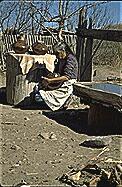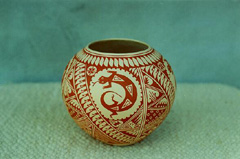This article on the potters and pottery of Juan Mata Ortíz, Chihuahua will set the stage for a monthly series entitled, “Among the Artists and the Cowboys.” Visitors to the village describe the place as “magical.” Readers of future stories will discover the charisma of Mata Ortíz and its people-both the potters and the cowboys. Men and women fashion the beautiful earthenware, and many of the men also double as cowboys. While the pottery is unique, the work of the vaqueros is mirrored in many communities throughout the Republic.
Enjoy this other view of Mexico – Michael Williams.

Our car rolled to a dusty halt at the top of the hill and the quaint Mexican village of adobe buildings stretched below us along the banks of the Río Palanganas. Gray tendrils of smoke rose lazily from the backyards of a dozen or so homes. Later, we would discover the smoke came from small open kilns where finely decorated pottery was being fired, one or two pieces at a time. Mata Ortíz is a village of highly talented craftspeople.
We started down the hill towards the little town, relieved that the stories about difficulties in getting to the village were highly exaggerated.
Mata Ortíz lies about four hours south and west of El Paso, Texas in northern Chihuahua. With the exception of the last 12 miles, which are over a gravel road, the trip was made on paved highway. There is even a city of 44,000, Nuevo Casas Grandes, with complete tourist facilities only 27 miles from the village. Accommodations are also now available within Mata Ortíz at the Posada de las Ollas.
Not quite sure where we were going, we tooled down the bumpy streets, exploring. Seeing two black-on-red slip bowls sitting on the windowsill of one of the homes, we stopped and piled out of our Trooper. The door to the house opened and a graceful, noble-looking woman with shoulder-length gray hair and skin the color of tanned leather greeted us.

By a stroke of luck, we had stopped at the home of Consolación Quezada, the older sister of Juan Quezada, the man who first made pottery in Mata Ortíz about 27 years ago. We were invited in to view her wares, displayed on a double bed.
The unglazed earthenware was astounding in its diversity and beauty. There were blood-red bowls embellished with black geometric designs, buff-colored pots impressed with star-like patterns, a large black clay frog, legs kicking in a swimming motion.
“All my family makes pottery,” Consolación said proudly, indicating pieces by a brother named Reynaldo, her sons and daughters, and of course, her own black-on-red pots.
About 27 years ago, Juan Quezada began making and painting pottery based on the shapes and designs of the prehistoric Indians from nearby ruins of Paquimé in Casas Grandes. By 1976, he was selling the decorative earthenware to traders from El Paso.
However, it was after his “discovery” by a businessman and amateur anthropologist, Spencer MacCallum, that Juan’s work improved and his popularity grew in the United States. At the end of the 1970s, this young man, with only a second grade education, had had his pottery featured in several museum exhibitions, including ones at the Heard Museum in Phoenix and the Southwest Museum in Los Angeles.

Now, there are over 300 potters — men, women, adolescents — working in the village. Many of them turn out original pots, bowls and plates, which some collectors believe rival or surpass the more famous Pueblo pottery of the southwestern US.
Mata Ortíz wares, often erroneously called “Casas Grandes pottery,” can be found in galleries throughout the Southwest and in other parts of the United States. A gallery in Cincinnati has a large collection. Shops from Santa Cruz, CA to Albany, NY are known to carry the naturally-made earthenware plates, pots and figures. Potters recently demonstrated their art in such diverse cities as Petaluma, CA, Denver, CO and Mystic, CT.
While the pottery can be found throughout the country, the fun is in visiting the village to meet and purchase pieces from the artists. There are no signs on the potters’ homes, but children will flag down a stranger’s car, or one may see a man or woman tending a small fire beside a home.
Under the smoldering dried cowchips or kindling, a piece of pottery is cooking. Visitors are invited to view and photograph the firing and, hopefully, buy that piece or another already finished and waiting inside the house.
The potters are often found working in their bedrooms which usually double as studios. There, a “tortilla” of clay is pressed into a plaster mold. Coils of clay are added and the walls are pinched and smoothed upwards by hand. None of the craftspeople uses a potter’s wheel. All the artwork is built by hand.
Sanding, polishing and painting are other steps to be completed before the pot is fired.
As much as possible, the potters adhere to the techniques of the ancient Paquimé Indians. The clays — gray, yellow, orange, red and white — are taken from the valley floor or the nearby foothills of the Sierra Madre Mountains. The paints are made from the clay or from crushed manganese, which is also mined locally.
Emphasis for many of the craftspeople is on the quality, not the large quantity of pieces churned out daily in many villages in central Mexico.
Prices are surprisingly reasonable. While they range from $1.00 for a tiny bowl to upwards of $300.00 for an exceptionally fine polychrome on white clay, the average price for a good quality pot is about $40.00. The potter signs each work of art. (Juan Quezada, the master potter, charges considerably more for his fine pieces).
While Nuevo Casas Grandes has a full range of tourist facilities, the Posada de las Ollas in Mata Ortíz, gives visitors a chance to literally live with the potters. The inn provides rooms, indoor plumbing and three meals per day. The Posada is a block from the village center and is surrounded by pottery families. Each day sees the artists’ children visiting to display their parents’ latest offerings.
For more information about the Posada, email to [email protected] or, on AOL, to Canuck8590. A large website is available at: https://www.mindspring.com/~mataort/matahp.htm
We bought several bowls, each signed by a different member of Consolación’s family on our first visit in 1989, including the black frog and one of Consolación’s unique black-on-red pots.
Consolación has been making pottery for 22 years. She enjoys the craft not only for the valuable supplement to her family income, but for the pleasure it gives her, despite nagging arthritis in her hands.
“My hands tell me I should stop making pots,” she says, “but my heart won’t let me.”
This warmth and pride in potterymaking is village-wide. It is easily transferred to visitors who often return to Mata Ortíz looking for new treasures.
